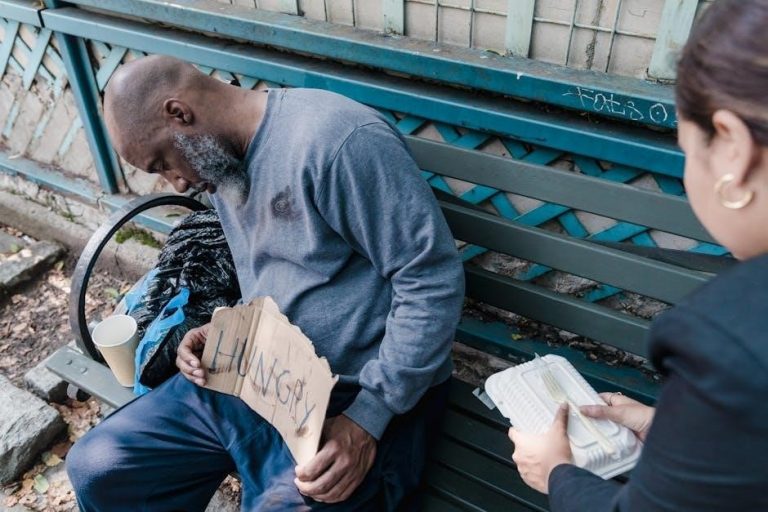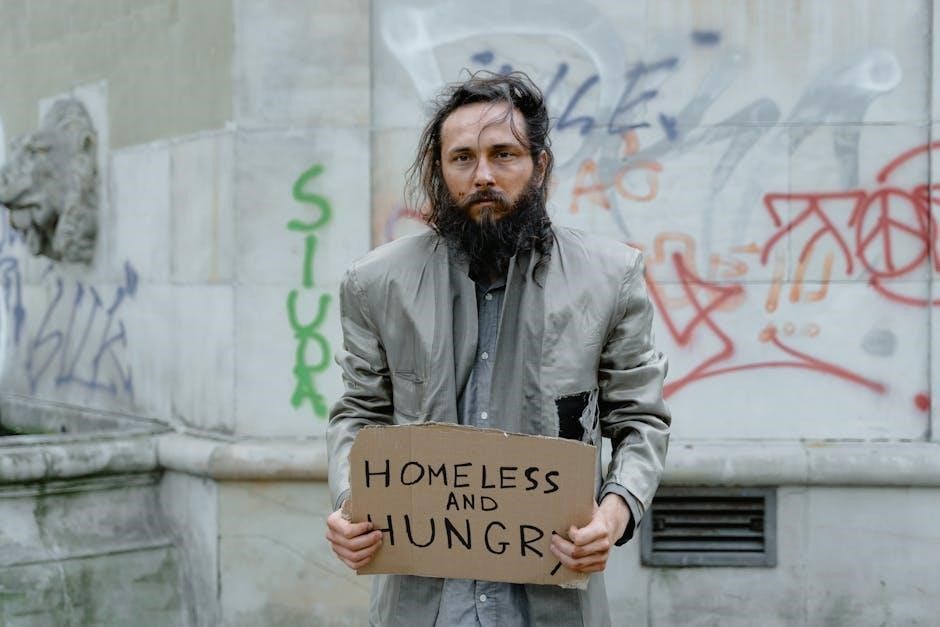
Poor Economics by Abhijit Banerjee and Esther Duflo offers a groundbreaking analysis of global poverty, challenging conventional wisdom with evidence-based solutions. Using data from 13 countries, the book explores the economic lives of the poor, revealing counterintuitive behaviors and strategies for effective poverty alleviation. A must-read for understanding the complexities of poverty and its eradication.
Overview of the Book
Poor Economics by Abhijit Banerjee and Esther Duflo delves into the complexities of global poverty, offering insights from 15 years of research across 13 countries. The book challenges common assumptions about poverty, exploring why the poor make seemingly irrational decisions. It emphasizes the importance of understanding the economic lives of the poor, such as their spending habits and financial strategies. By combining rigorous data with real-world examples, the authors propose practical solutions to alleviate poverty, making it a vital resource for policymakers and researchers alike.
Importance of Understanding Poverty
Understanding poverty is crucial for designing effective solutions to global inequality. By examining the economic lives of the poor, we uncover the nuanced decision-making that drives their survival strategies. The poor often face paradoxes, such as borrowing to save or paying for unnecessary drugs while skipping free immunizations. These insights reveal the complexity of poverty, emphasizing the need for evidence-based policies. Without this understanding, efforts to alleviate poverty risk being misdirected or ineffective, highlighting the importance of Banerjee and Duflo’s research in shaping impactful interventions.
Authors and Their Contributions
Abhijit Banerjee and Esther Duflo pioneer evidence-based approaches in development economics, utilizing randomized control trials and founding J-PAL to address global poverty effectively.
Abhijit Banerjee and Esther Duflo
Abhijit Banerjee and Esther Duflo are renowned economists known for their groundbreaking work in development economics. They co-founded the Abdul Latif Jameel Poverty Action Lab (J-PAL), pioneering the use of randomized control trials to rigorously test anti-poverty interventions. Their collaborative research spans multiple countries, offering insights into the complex economic lives of the poor. Banerjee and Duflo’s innovative approaches have earned them global recognition, including the Nobel Prize in Economics for their evidence-based solutions to poverty alleviation.
Their Research and J-PAL Initiative
Abhijit Banerjee and Esther Duflo’s research revolutionized development economics through their work at the Abdul Latif Jameel Poverty Action Lab (J-PAL). By employing randomized control trials, they rigorously tested anti-poverty interventions worldwide. Their research spans 13 countries, addressing issues like microfinance, healthcare, and education. This evidence-based approach has informed global policy and earned them the Nobel Prize in Economics, showcasing the impact of their innovative methods in understanding and addressing poverty effectively.

Key Concepts and Findings
Poor Economics challenges traditional views on poverty by revealing the complex economic behaviors of the poor. It highlights the “poverty trap” and examines how limited resources shape decisions, emphasizing evidence from 13 countries to propose targeted, scalable solutions for poverty alleviation.
The Poverty Trap
The concept of the “poverty trap” is central to Poor Economics, where individuals remain impoverished due to limited resources and high costs of improving their circumstances. Banerjee and Duflo explain how the poor face unique challenges, such as lack of access to credit, healthcare, and education, which trap them in a cycle of poverty. Small financial shocks can devastate their lives, making it nearly impossible to invest in opportunities that could improve their economic standing. This trap perpetuates inequality and limits social mobility.
Economic Lives of the Poor
In Poor Economics, Banerjee and Duflo delve into the daily financial struggles of the poor, revealing how they manage limited resources. The book highlights how the poor make complex trade-offs, often spending on necessities while foregoing investments in healthcare or education. Data from 13 countries shows that the poor face unique challenges, such as high costs for basic goods and limited access to credit; These insights challenge stereotypes, offering a nuanced understanding of the economic realities faced by the poor.

Methodology and Approach
The book employs randomized control trials (RCTs) and data from 13 countries to rigorously test poverty interventions, ensuring evidence-based policy recommendations.
Randomized Control Trials
Randomized control trials (RCTs) are central to the methodology in Poor Economics, providing rigorous evidence to test anti-poverty interventions. By conducting RCTs across multiple developing countries, Banerjee and Duflo identify which programs effectively improve the lives of the poor. This approach allows for precise insights into why certain strategies succeed or fail, ensuring policies are grounded in empirical evidence rather than assumptions. Their pioneering use of RCTs has revolutionized development economics and informed scalable solutions for poverty alleviation.
Data from 13 Countries
The book utilizes extensive survey data from 13 countries to provide insights into the lives of the poor and extremely poor. This diverse dataset captures the economic behaviors, challenges, and coping mechanisms of individuals living on less than $2 per day. By analyzing this data, Banerjee and Duflo reveal patterns in savings, borrowing, and spending habits, offering a nuanced understanding of poverty’s complexities. This comprehensive approach ensures their findings are both robust and applicable across varied contexts.
Case Studies and Examples
Poor Economics illustrates poverty’s complexities through real-life examples, showcasing how the poor make decisions on healthcare, savings, and debt. These case studies highlight the challenges and innovative solutions observed across diverse contexts, providing practical insights into poverty alleviation strategies.
Real-Life Applications
The book provides practical examples of how poverty solutions are implemented, such as microfinance programs and health interventions. These real-life applications demonstrate the effectiveness of evidence-based policies in improving the lives of the poor. By focusing on specific case studies, Banerjee and Duflo show how understanding the economic decisions of the poor can lead to impactful and sustainable poverty reduction strategies worldwide.
Strategies for Poverty Alleviation
Poor Economics outlines innovative strategies to tackle poverty, emphasizing targeted interventions like microfinance, healthcare access, and education. Banerjee and Duflo advocate for policies that address the specific needs of the poor, such as affordable healthcare and financial services. They argue that small, incremental changes can have a significant impact, challenging one-size-fits-all approaches and promoting localized solutions for sustainable poverty reduction.
Microfinance and Its Impact
Microfinance provides financial access to the poor, enabling entrepreneurship and stability. However, its impact on poverty reduction is debated, as shown in Poor Economics.
Role in Poverty Reduction
Microfinance plays a crucial role in poverty reduction by providing financial services to the poor, enabling entrepreneurship and economic stability. It empowers individuals, especially women, to invest in small businesses and manage risks. By offering access to loans and savings, microfinance helps the poor improve their livelihoods and escape poverty traps. However, its effectiveness varies, and it is most successful when complemented by education and other support systems, as highlighted in Poor Economics.
Critique and Effectiveness
While microfinance has been praised for its potential to uplift the poor, its effectiveness is debated. Critics argue that high interest rates and lack of financial literacy can trap borrowers in debt cycles. Poor Economics highlights that microfinance is not a standalone solution but works best when combined with education and social programs. Its impact varies widely, proving beneficial in some contexts but less so in others, emphasizing the need for nuanced approaches to poverty alleviation.

Behavioral Economics Insights
Poor Economics reveals how the poor’s decision-making is shaped by survival instincts, aspirations, and cognitive constraints, often leading to counterintuitive choices like borrowing to save despite scarce resources.
Decision-Making Among the Poor
The book highlights that the poor often make seemingly irrational decisions due to resource constraints and cognitive overload. For instance, they might borrow at high interest rates to meet immediate needs or forego free immunizations due to logistical challenges. These choices, while appearing suboptimal, are rooted in survival strategies and limited access to information. Banerjee and Duflo emphasize that understanding these behaviors is crucial for designing effective poverty interventions.
Challenges in Economic Behavior
The poor face unique challenges in economic behavior, such as high transaction costs, lack of access to credit, and limited information. These factors often lead to inefficiencies and reinforce poverty traps. Banerjee and Duflo illustrate how these challenges result in suboptimal decisions, such as paying for unnecessary drugs while skipping free vaccines. Addressing these behavioral challenges requires tailored interventions that account for the specific contexts of the poor.

Policy Implications and Recommendations
Poor Economics emphasizes evidence-based policymaking, advocating for targeted interventions and cost-effective strategies to address poverty. Collaboration between governments, NGOs, and researchers is crucial for sustainable solutions.
Effective Interventions
Poor Economics highlights the importance of evidence-based interventions, such as microfinance programs, healthcare initiatives, and educational support. Randomized control trials (RCTs) are emphasized as a tool to test policy effectiveness. The authors argue that small, targeted interventions, like providing mosquito nets or deworming pills, can have significant impacts on poverty reduction. They also stress the need for cost-effective solutions that address specific challenges faced by the poor, ensuring resources are used efficiently to maximize benefits. Banerjee and Duflo’s recommendations aim to create sustainable pathways out of poverty.
Future Directions in Policy
Banerjee and Duflo advocate for a shift in policy thinking, emphasizing evidence-based approaches over ideological assumptions. They propose scaling successful interventions, such as microfinance and targeted healthcare, while ensuring programs are adaptable to local contexts. Future policies should prioritize cost-effectiveness, transparency, and collaboration between governments, NGOs, and researchers. By leveraging randomized control trials, policymakers can identify and expand proven solutions, fostering sustainable progress in reducing global poverty and improving livelihoods for the world’s poorest populations.
Reviews and Recognition
Poor Economics received widespread acclaim, winning the 2011 Goldman Sachs Business Book of the Year award. Banerjee and Duflo’s Nobel Prize in 2019 further cemented its impact, solidifying its reputation as a landmark work in development economics.
Critical Acclaim
Poor Economics has been praised for its innovative approach to understanding poverty. Reviewers highlight its use of rigorous research and real-world examples, making it accessible and impactful. The book’s ability to challenge common misconceptions about poverty has earned it a reputation as a seminal work in development economics. Its clear and engaging writing style has also been commended, contributing to its widespread recognition and acclaim in both academic and popular circles.
Awards and Honors
Poor Economics received the Goldman Sachs Business Book of the Year award in 2011. Its authors, Abhijit Banerjee and Esther Duflo, were awarded the Nobel Prize in Economics in 2019 for their groundbreaking research on poverty alleviation. The book’s impact has been recognized globally, solidifying its place as a landmark publication in the field of development economics.
Poor Economics concludes by emphasizing the need for evidence-based approaches to combat poverty, offering practical solutions rooted in rigorous research and real-world applications.
Final Thoughts
Poor Economics reshapes our understanding of poverty by blending rigorous research with real-world insights. Banerjee and Duflo’s evidence-based approach challenges simplistic solutions, emphasizing the complexity of poverty and the need for tailored interventions. Their work, recognized globally, including with the Nobel Prize, underscores the importance of empirical methods in development economics. The book remains a vital resource for policymakers and researchers, offering actionable strategies to address global poverty effectively. Readers are encouraged to explore the Poor Economics book PDF for deeper insights.
Call to Action
Download the Poor Economics book PDF to gain insights into innovative solutions for global poverty. Explore evidence-based strategies and pioneering research by Abhijit Banerjee and Esther Duflo. This book is a must-read for anyone passionate about understanding and addressing poverty effectively. Access the PDF today and discover how to make a meaningful impact on transforming lives worldwide. Your journey toward creating a difference starts here.
Availability and Access
The Poor Economics book PDF is widely available for download on platforms like Scribd and other online repositories, ensuring easy access to its groundbreaking insights on poverty.
The Poor Economics book PDF is readily available for download online, offering a convenient way to access the authors’ groundbreaking insights. Platforms like Scribd provide free access to the PDF version, making it easy for readers worldwide to explore the book’s innovative approaches to understanding and alleviating poverty. With its detailed research and real-world examples, the PDF format ensures that the content is easily shareable and accessible for those interested in development economics and global poverty solutions.
Downloading and Reading
Downloading the Poor Economics PDF is straightforward, with options available on Scribd and other platforms. Readers can access the full text for free, enabling easy reading on devices like smartphones, tablets, or computers. The PDF format preserves the book’s structure, ensuring a seamless reading experience. This accessibility makes it simple for anyone to engage with Banerjee and Duflo’s pioneering research on global poverty and its solutions, anytime and anywhere.
